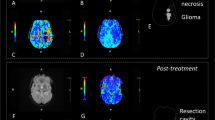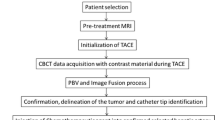Abstract
Purpose
We developed a semi-automated volumetric software, NPerfusion, to segment brain tumors and quantify perfusion parameters on whole-brain CT perfusion (WBCTP) images. The purpose of this study was to assess the feasibility of the software and to validate its performance compared with manual segmentation.
Methods
Twenty-nine patients with pathologically proven brain tumors who underwent preoperative WBCTP between August 2012 and February 2015 were included. Three perfusion parameters, arterial flow (AF), equivalent blood volume (EBV), and Patlak flow (PF, which is a measure of permeability of capillaries), of brain tumors were generated by a commercial software and then quantified volumetrically by NPerfusion, which also semi-automatically segmented tumor boundaries. The quantification was validated by comparison with that of manual segmentation in terms of the concordance correlation coefficient and Bland-Altman analysis.
Results
With NPerfusion, we successfully performed segmentation and quantified whole volumetric perfusion parameters of all 29 brain tumors that showed consistent perfusion trends with previous studies. The validation of the perfusion parameter quantification exhibited almost perfect agreement with manual segmentation, with Lin concordance correlation coefficients (ρ c) for AF, EBV, and PF of 0.9988, 0.9994, and 0.9976, respectively. On Bland-Altman analysis, most differences between this software and manual segmentation on the commercial software were within the limit of agreement.
Conclusions
NPerfusion successfully performs segmentation of brain tumors and calculates perfusion parameters of brain tumors. We validated this semi-automated segmentation software by comparing it with manual segmentation. NPerfusion can be used to calculate volumetric perfusion parameters of brain tumors from WBCTP.




Similar content being viewed by others
References
Bauer S, Wiest R, Nolte LP, Reyes M (2013) A survey of MRI-based medical image analysis for brain tumor studies. Phys Med Biol 58(13):R97–129. doi:10.1088/0031-9155/58/13/R97
Prastawa M, Bullitt E, Moon N, Van Leemput K, Gerig G (2003) Automatic brain tumor segmentation by subject specific modification of atlas priors. Acad Radiol 10(12):1341–1348
Chen T, Guo D, Fang Z, Zhong W, Zhao J, Jiang Y (2014) Preliminary study of whole-brain CT perfusion imaging in patients with intracranial tumours adjacent to large blood vessels. Clin Radiol 69(1):e25–e32. doi:10.1016/j.crad.2013.08.010
Coolens C, Driscoll B, Chung C, Shek T, Gorjizadeh A, Menard C, Jaffray D (2015) Automated voxel-based analysis of volumetric dynamic contrast-enhanced CT data improves measurement of serial changes in tumor vascular biomarkers. Int J Radiat Oncol Biol Phys 91(1):48–57. doi:10.1016/j.ijrobp.2014.09.028
Hiwatashi A, Togao O, Yamashita K, Kikuchi K, Yoshimoto K, Mizoguchi M, Suzuki SO, Yoshiura T, Honda H (2016) Evaluation of glioblastomas and lymphomas with whole-brain CT perfusion: comparison between a delay-invariant singular-value decomposition algorithm and a Patlak plot. Journal of neuroradiology Journal de neuroradiologie. doi:10.1016/j.neurad.2016.01.147
Shankar JJ, Lum C (2011) Whole brain CT perfusion on a 320-slice CT scanner. Indian J Radiol Imaging 21(3):209–214. doi:10.4103/0971-3026.85370
Xyda A, Haberland U, Klotz E, Jung K, Bock HC, Schramm R, Knauth M, Schramm P (2012) Diagnostic performance of whole brain volume perfusion CT in intra-axial brain tumors: preoperative classification accuracy and histopathologic correlation. Eur J Radiol 81(12):4105–4111. doi:10.1016/j.ejrad.2012.08.005
Miles KA (1991) Measurement of tissue perfusion by dynamic computed tomography. Br J Radiol 64(761):409–412. doi:10.1259/0007-1285-64-761-409
Patlak CS, Blasberg RG (1985) Graphical evaluation of blood-to-brain transfer constants from multiple-time uptake data. Generalizations. Journal of cerebral blood flow and metabolism : official journal of the International Society of Cerebral Blood Flow and Metabolism 5(4):584–590. doi:10.1038/jcbfm.1985.87
Neil Birkbeck DC, Martin Jagersand, Albert Murtha, Tibor Kesztyues (2009) An interactive graph cut method for brain tumor segmentation. Workshop on Applications of Computer Vision (WACV), pp 1–7. doi:10.1109/WACV.2009.5403049
Boykov Y, Funka-Lea G (2006) Graph cuts and efficient N-D image segmentation. Int J Comput Vis 70(2):109–131. doi:10.1007/s11263-006-7934-5
Essig M, Shiroishi MS, Nguyen TB, Saake M, Provenzale JM, Enterline D, Anzalone N, Dorfler A, Rovira A, Wintermark M, Law M (2013) Perfusion MRI: the five most frequently asked technical questions. AJR Am J Roentgenol 200(1):24–34. doi:10.2214/ajr.12.9543
Wintermark M, Sesay M, Barbier E, Borbely K, Dillon WP, Eastwood JD, Glenn TC, Grandin CB, Pedraza S, Soustiel JF, Nariai T, Zaharchuk G, Caille JM, Dousset V, Yonas H (2005) Comparative overview of brain perfusion imaging techniques. Stroke; a journal of cerebral circulation 36(9):e83–e99. doi:10.1161/01.STR.0000177884.72657.8b
Geer CP, Simonds J, Anvery A, Chen MY, Burdette JH, Zapadka ME, Ellis TL, Tatter SB, Lesser GJ, Chan MD, McMullen KP, Johnson AJ (2012) Does MR perfusion imaging impact management decisions for patients with brain tumors? A prospective study. AJNR Am J Neuroradiol 33(3):556–562. doi:10.3174/ajnr.A2811
Korfiatis P, Erickson B (2014) The basics of diffusion and perfusion imaging in brain tumors. Appl Radiol 43(7):22–29
Bisdas S, Medov L, Baghi M, Konstantinou GN, Wagenblast J, Thng CH, Vogl TJ, Koh TS (2008) A comparison of tumour perfusion assessed by deconvolution-based analysis of dynamic contrast-enhanced CT and MR imaging in patients with squamous cell carcinoma of the upper aerodigestive tract. Eur Radiol 18(4):843–850. doi:10.1007/s00330-007-0827-3
Jain R (2011) Perfusion CT imaging of brain tumors: an overview. AJNR Am J Neuroradiol 32(9):1570–1577. doi:10.3174/ajnr.A2263
Pillai JJ (2013) Functional brain tumor imaging. Springer, New York
Konstas AA, Goldmakher GV, Lee TY, Lev MH (2009) Theoretic basis and technical implementations of CT perfusion in acute ischemic stroke, part 2: technical implementations. AJNR Am J Neuroradiol 30(5):885–892. doi:10.3174/ajnr.A1492
Mazzara GP, Velthuizen RP, Pearlman JL, Greenberg HM, Wagner H (2004) Brain tumor target volume determination for radiation treatment planning through automated MRI segmentation. Int J Radiat Oncol Biol Phys 59(1):300–312. doi:10.1016/j.ijrobp.2004.01.026
Hakyemez B, Erdogan C, Bolca N, Yildirim N, Gokalp G, Parlak M (2006) Evaluation of different cerebral mass lesions by perfusion-weighted MR imaging. Journal of magnetic resonance imaging : JMRI 24(4):817–824. doi:10.1002/jmri.20707
Zimny A, Sasiadek M (2011) Contribution of perfusion-weighted magnetic resonance imaging in the differentiation of meningiomas and other extra-axial tumors: case reports and literature review. J Neuro-Oncol 103(3):777–783. doi:10.1007/s11060-010-0445-9
Larke FJ, Kruger RL, Cagnon CH, Flynn MJ, McNitt-Gray MM, Wu X, Judy PF, Cody DD (2011) Estimated radiation dose associated with low-dose chest CT of average-size participants in the National Lung Screening Trial. AJR Am J Roentgenol 197(5):1165–1169. doi:10.2214/ajr.11.6533
Cho SK, Na DG, Ryoo JW, Roh HG, Moon CH, Byun HS, Kim JH (2002) Perfusion MR imaging: clinical utility for the differential diagnosis of various brain tumors. Korean J Radiol 3(3):171–179. doi:10.3348/kjr.2002.3.3.171
Kumar VA, Knopp EA, Zagzag D (2010) Magnetic resonance dynamic susceptibility-weighted contrast-enhanced perfusion imaging in the diagnosis of posterior fossa hemangioblastomas and pilocytic astrocytomas: initial results. J Comput Assist Tomogr 34(6):825–829. doi:10.1097/RCT.0b013e3181ef77e2
Chen Y, Tachibana O, Hasegawa M, Xu R, Hamada J, Yamashita J, Hashimoto N, Takahashi JA (2006) Absence of tight junctions between microvascular endothelial cells in human cerebellar hemangioblastomas. Neurosurgery 59(3):660–670 . doi:10.1227/01.neu.0000223372.18607.d7discussion 660-670
Author information
Authors and Affiliations
Corresponding author
Ethics declarations
Funding
No funding was received for this study.
Conflict of interest
The authors declare that they have no conflict of interest.
Ethical approval
All procedures performed in the studies involving human participants were in accordance with the ethical standards of the institutional and/or national research committee and with the 1964 Helsinki Declaration and its later amendments or comparable ethical standards.
Informed consent
For this type of study formal consent is not required.
Electronic supplementary material
ESM 1
(PDF 474 kb)
Rights and permissions
About this article
Cite this article
Chae, S.Y., Suh, S., Ryoo, I. et al. A semi-automated volumetric software for segmentation and perfusion parameter quantification of brain tumors using 320-row multidetector computed tomography: a validation study. Neuroradiology 59, 461–469 (2017). https://doi.org/10.1007/s00234-017-1790-6
Received:
Accepted:
Published:
Issue Date:
DOI: https://doi.org/10.1007/s00234-017-1790-6




